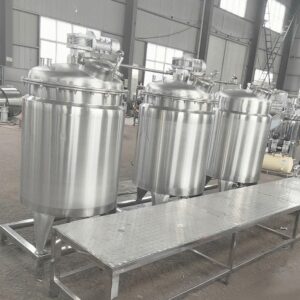A dispersion mixing tank is a specialized industrial vessel designed to mix, blend, and disperse various materials, typically liquids with solids or other liquids. The tank is equipped with high-shear mixing mechanisms that ensure thorough and uniform dispersion of ingredients, making it ideal for applications where consistency and precision are crucial. This type of tank is widely used in industries such as food and beverage, pharmaceuticals, chemicals, cosmetics, and more.
Key Features and Components
1. High-Shear Mixer: A powerful mixing mechanism that creates a high-speed, high-shear environment within the tank. This is essential for breaking down particles and ensuring even distribution throughout the liquid.
2. Variable Speed Control: Allows operators to adjust the mixing speed to suit different materials and desired outcomes, ensuring optimal mixing performance.
3. Stainless Steel Construction: Typically made from high-grade stainless steel (SS304 or SS316), ensuring durability, corrosion resistance, and compliance with hygiene standards.
4. Jacketed Exterior: Optional feature that allows for temperature control through heating or cooling fluids circulated in the jacket. This is important for processes that require specific thermal conditions.
5. Baffles: Internal structures that help improve mixing efficiency by creating turbulence and preventing the formation of vortices.
6. Control Panel: Centralized system for monitoring and adjusting mixing parameters such as speed, temperature, and mixing time.
7. Discharge Valve: Facilitates the easy removal of the mixed product from the tank, minimizing waste and ensuring efficient workflow.
8. Lid and Access Ports: Provide access for adding ingredients, sampling, and cleaning. The lid also helps to prevent contamination and spillage.
9. Level Indicators and Sensors: Allow operators to monitor the liquid level and other critical parameters to ensure precise control over the mixing process.
Applications
– Food and Beverage Industry: Mixing sauces, dressings, beverages, dairy products, and other food items that require uniform dispersion of ingredients.
– Pharmaceuticals: Preparing suspensions, emulsions, and other pharmaceutical formulations that require precise mixing.
– Chemicals: Formulating chemical solutions, dispersions, and suspensions.
– Cosmetics: Blending creams, lotions, and other personal care products.
– Paints and Coatings: Ensuring uniform dispersion of pigments and other components in paints and coatings.
Benefits
1. Enhanced Mixing Efficiency: High-shear mixing ensures thorough and uniform dispersion, improving product consistency and quality.
2. Versatility: Suitable for a wide range of materials and applications, accommodating various viscosities and mixing requirements.
3. Durability and Hygiene: Stainless steel construction ensures longevity, ease of cleaning, and compliance with industry hygiene standards.
4. Precise Control: Adjustable mixing parameters allow for precise control over the mixing process, ensuring optimal results.
5. Temperature Regulation: Jacketed design allows for precise temperature control, essential for processes requiring specific thermal conditions.
Technical Specifications
– Capacity: Available in various sizes, typically ranging from 50 liters to several thousand liters, depending on the application needs.
– Mixing Speed: Adjustable speeds, typically ranging from 50 to 3000 RPM, depending on the high-shear mixer specifications.
– Temperature Range: Capable of maintaining temperatures from -10°C to 200°C, depending on the heating and cooling system specifications.
– Material: High-grade stainless steel (SS304 or SS316) construction for durability and compliance with industry standards.
– Power Supply: Designed to operate on standard industrial electrical supplies, with options for custom configurations.
Usage Instructions
1. Setup: Ensure the dispersion mixing tank is installed on a stable foundation, with all utility connections (power, water, steam) properly connected.
2. Preparation: Load the ingredients into the tank, ensuring they are within the capacity limits and properly measured.
3. Parameter Settings: Use the control panel to set the desired mixing speed, temperature, and duration for the process.
4. Operation: Start the mixing process, monitoring the parameters and making adjustments as necessary to maintain optimal conditions.
5. Discharge: Once the mixing is complete, use the discharge valve to remove the mixed product efficiently.
6. Cleaning: Thoroughly clean the tank, mixer, and any other components after use to prevent cross-contamination and ensure hygiene for subsequent batches.
The dispersion mixing tank is an essential piece of equipment for industries that require precise and efficient mixing and dispersion of materials. Its advanced design, featuring high-shear mixing and optional temperature control, makes it ideal for a wide range of applications, from food processing to pharmaceuticals, chemicals, and cosmetics. By ensuring uniform dispersion and precise control over the mixing process, the dispersion mixing tank helps enhance product quality, consistency, and overall production efficiency.





Reviews
There are no reviews yet.